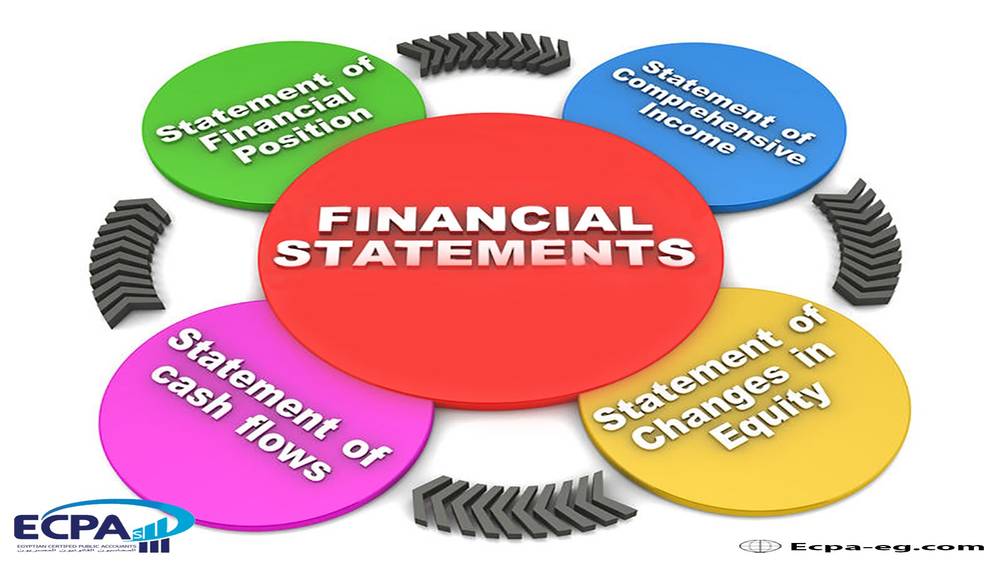Financial Statements
Through which the value of the company's assets, investments, property and liabilities can be identified, the value of profit or loss achieved, cash inflows and outflows from the company can be measured.
![]() Amer Ibrahim - • External audit and audit
Amer Ibrahim - • External audit and audit

Financial Center List :-
CopyFinancial Center List :-
CopyNon-current assets :
The value of fixed assets owned by the company that it needs to carry out its activity during a number of financial periods as well as any other assets that are difficult to convert into cash easily .
Current Assets :-
CopyWhat a company requires to operate its day-to-day operations and pay its current expenses, called short-term assets because they are converted into cash during the company's financial year often, and current assets are usually listed at their current or market value .
Property Rights :-
CopyEquity includes the value of the funds through which the company was established and collected from partners or shareholders at the beginning of the establishment of the company in addition to the profits generated from practicing the activity during the life of the establishment - in other words, equity is defined as the money that is returned to the shareholders of the company when liquidating all assets and paying all obligations .
Current Obligations :-
CopyIt is the short-term financial obligations due from the company within one year or within a normal operating cycle for the company's investment and commercial operations.
Long-term liabilities :-
CopyThey are undue liabilities during the next 12 months and often include bonds, loans, deferred tax liabilities, etc.
Income Statement :-
CopyThe Revenue/Sales :
CopyThe value of revenues or sales resulting from the company's basic activity during the financial period.
Revenue / Sales Cost :
CopyThe costs incurred by the company related to the basic activity of the company or the so-called direct costs.
Total Profit / (Loss) :
CopyProfit or loss resulting from the exercise of the company's basic activity and before deducting any other expenses related to the company during the financial period.
Depreciation :
CopyThe value of depreciation expense of fixed assets (not related to production) during the financial period.
Administrative expenses :
CopyFixed expenses incurred by the company regardless of the company's productivity.
Marketing expenses :
CopyThe company's marketing and advertising expenses.
Financing Expenses :
CopyCompany expenses related to borrowing from third parties (interest on facilities of all kinds).
Other Revenues :
CopyAny revenues other than revenues generated from the main activity of the company (such as profits from the sale of fixed assets & profit on currency differences).
Profits (losses) of the activity before tax :
CopyNet profit / loss of the company before accounting and exclusion of outstanding tax liabilities.
Income tax allowance :
CopyIncome tax payable on the company's profits.
Net profit after tax :
CopyNet profit / loss of the company.
Statement of comprehensive income :-
Copy1- Net profit / loss for the period based on the company's income statement .
2- Profits resulting from works not related to the main activity of the company .
3- Losses resulting from business not related to the main activity of the company .
4- Net Profit/(Loss) Comprehensive .
List of change in equity :-
Copy1- Equity-held account balances at the beginning of the financial period.
2- Net profit / loss for the financial period resulting in the income statement.
3- Financial movements that took place during the period (increase / decrease of capital) or (settlements on carry-over profits).
4- Dividends made to (partners / shareholders) during the financial period based on the resolutions of the General Assembly.
5 Equity-held account balances at the end of the financial period.
Cash flows from operating activities :-
CopyNet profit (loss) of the period.
Net profit or loss of the company for the period based on the income statement.
Adjustments to match the net profit to the net funds arising from operating activities : -
CopyAccounting costs that did not consume any cash from the company in an actual and tangible manner.
Depreciation of fixed assets : -
CopyThe value of changes that occurred in the balances of the accounts of assets and current liabilities during the financial period (whether by increase or decrease) - which affected the company's cash balance.
- Operating profit (loss) before the change in working capital .
- Decrease (increase) in stock .
- Decrease (increase) in customers and receivables .
- Decrease (increase) in debtors and debit balances .
- Increase (decrease) in suppliers and payment papers .
- Increase (decrease) in creditors and other credit balances .
- Increase (decrease) in long-term liabilities .
Cash used in operation : -
CopyNet cash available from (used in) operating activities .
Cash flows from investment activities :-
CopyThe value of cash entering / leaving the company for the purpose of investing in long-term assets or any other investments.
- Receipts (payments) for fixed assets and investments .
- Receipts (payments) for fixed assets and investments .
- Receipts (payments) on intangible assets .
- Net cash used in investment activities .
Cash flows from financing activities :-
CopyThe value of cash entering / leaving the company for the purposes of increasing or reducing the capital, dividends to partners or financing from others
- Increase (decrease) in capital.
- Paid dividends.
- Net cash from financing activities.
- Net movement of cash and the like.
Cash and cash equivalents at the beginning of the period:
For cash and cash equivalents at the end of the period:
The balance of actual cash at the end of the period and shown in the financial statements for the period.